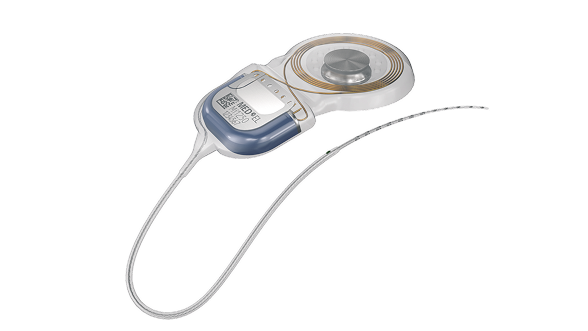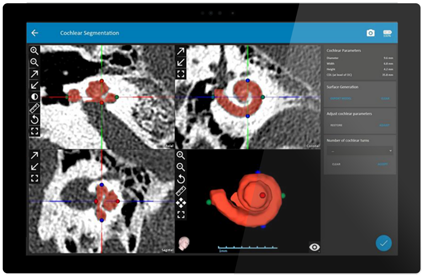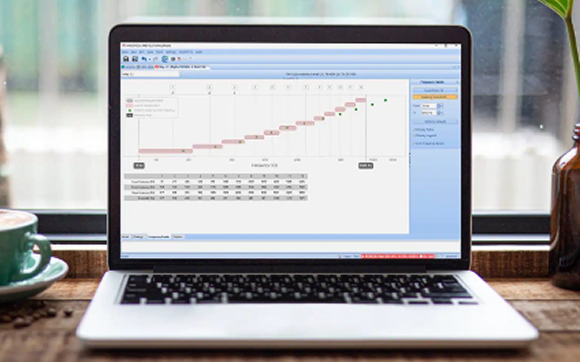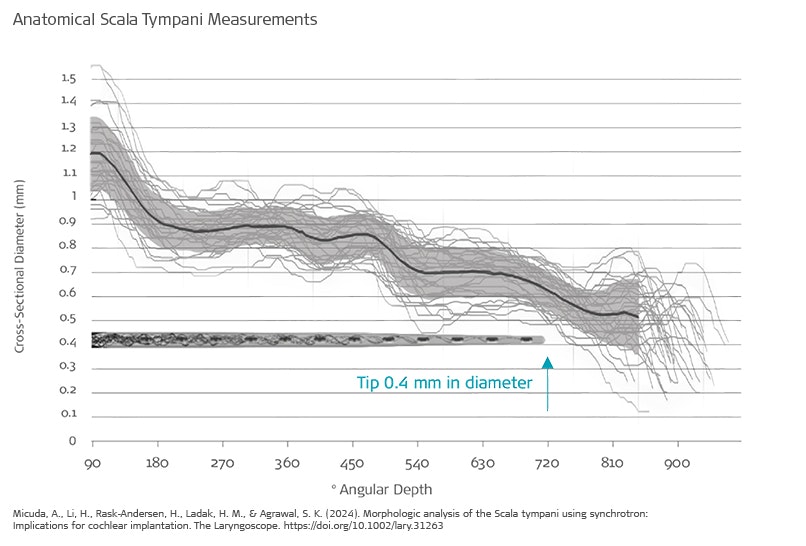MED-EL Cochlear Implant Electrode Arrays
There is a growing shift towards personalized treatment in healthcare—and cochlear implants are no exception. Since cochleae naturally vary in size and shape, MED-EL has designed cochlear implant electrodes to be tailored to match each ear’s size and anatomy.
Think of your most comfortable pair of shoes. They are pleasant to wear because they are the right size to fit your feet and have soft insoles that adapt to their shape. Now imagine soft, flexible electrodes that can gently adapt to the shape of your cochlea and can be individualized to fit the size of your ear. That’s how we designed our FLEX electrodes.
The anatomical structures important for cochlear stimulation, such as Rosenthal’s canal and the spiral ganglion, are known to extend deeper than one and a half turns—even up to two full turns—inside normally developed cochleae.[ft][ft][ft][ft][ft]
Only an electrode that’s long enough to span the anatomical structures important for stimulation can make full use of each cochlea’s potential and enable recipients to fully benefit from cochlear implant technology. While ensuring future cochlear health and acting as a crucial bridge between technology and nature, MED-EL’s FLEX electrodes connect hundreds of thousands of people to their loved ones with the closest to natural hearing every day.
- Proven Hearing Preservation
Our flexible electrode arrays help preserve delicate cochlear structures, enabling atraumatic scala tympani insertion and proven hearing preservation. [ft][ft][ft][ft][ft][ft][ft][ft]
- An Electrode to Fit Each Ear
With our comprehensive electrode portfolio, you can easily choose the ideal array to match each cochlea’s length to reach beyond one and a half turns.[ft][ft]
- Complete Cochlear Coverage
Only MED-EL offers electrode arrays long enough to cover beyond one and a half turns and provide the benefits that come with stimulating the apical region.[ft][ft][ft][ft][ft][ft][ft][ft][ft][ft]
- Closest to Natural Frequency Match
With FineHearing replicating phase locking in the apical region, only MED-EL provides both tonotopic (place) and temporal (rate) coding of lower frequencies for the highest hearing quality.[ft][ft][ft][ft]

Individualized Cochlear Implants
Our philosophy is straightforward: Adapt the cochlear implant to your patient’s cochlea.
With normal anatomy, human cochlear ducts typically vary in length from 28 to over 36 mm.[ft] So when it comes to cochlear implant electrode arrays, one size cannot fit all. That’s why we designed our FLEX series arrays to provide the optimal length for the full range of cochlear sizes.[ft][ft]
With six FLEX arrays available in sizes from 20–34 mm, you can achieve complete cochlear coverage and full electrode insertion for each patient.* And with OTOPLAN, we provide intuitive otological surgery planning software so you can easily visualize the insertion depth of the electrode array based on each cochlea’s measurements.** [ft]

1
FLEX20
2
FLEX24
3
FLEX26
4
FLEX28
5
FLEXSoft
6
FLEX34






“Using 3D imaging during the pre-operative planning may improve clinicians’ confidence to implant longer electrode arrays, where appropriate, to achieve optimum hearing outcomes.”
Távora-Vieira et al., 2023
“From an anatomical standpoint, optimal reach of the spiral ganglion would seem to be at two turns [680°-720°], thereby covering the entire frequency range.”
Li et al., 2021

Closest to Natural Hearing
In the cochlea, natural frequency response is intricately ordered on a logarithmic scale across two full turns. This tonotopic place-pitch frequency response throughout the whole cochlea allows frequency mapping along a clear, logical path.[ft]
How do we provide the closest to natural hearing with our electrode arrays? By aligning our electrodes as closely as possible to the natural tonotopic place across the whole cochlea. What does more natural sound quality mean for your patients? More natural music enjoyment, much better hearing in everyday life, and the best possible hearing experience with their cochlear implant. [ft][ft][ft][ft][ft]
“After losing my hearing, it was difficult to listen to music. And now with the cochlear implant, I can hear more overtones and undertones. I appreciate music to the fullest.”
Russell Tyler, MED-EL cochlear implant recipient and oboist

Designed for Structure & Hearing Preservation
A deaf ear is not a dead ear. The cochlea is filled with intricate structures that we want to protect. That’s why, for over 30 years, we’ve worked to create our soft, flexible electrode arrays. Uniquely engineered, FLEX electrode arrays are the most atraumatic electrode arrays available.[ft][ft]
MED-EL’s FLEX electrodes have the lowest reported incidence of tip fold-over, preserve the delicate structures of the inner ear, and gently adapt to the individual cochlea for atraumatic and reliable electrode insertion.[ft][ft]
Soft, Flexible Electrode Arrays
Our electrodes gently adapt to the unique shape of each cochlea while bringing contacts close to neural targets.
Wave-Shaped Wires
Uniquely shaped flexible wires bend more easily, which helps reduce rigidity and insertion forces in comparison to straight-wire designs.[ft]
Optimal Contact Spacing
Our design offers an ideal combination of mechanical flexibility and channel spacing to reduce insertion force and avoid overlapping stimulation channels.[ft][ft]
Round Window Insertion
With no need for an insertion stylet, our arrays are atraumatically inserted through the round window into the scala tympani, avoiding drilling trauma from a cochleostomy.[ft]
FLEX-Tip Technology
FLEX arrays feature a tapered, rounded tip that gently glides along the scala tympani during insertion, avoiding damage to the basilar membrane and delicate structures.[ft][ft]

“With our FLEX electrode design, MED-EL has engineered the only cochlear implants proven to preserve residual hearing in many recipients.”
Ingeborg Hochmair, Founder and CEO of MED-EL

Why MED-EL:
A Trusted Partner
For more than 35 years, MED-EL has been a trusted partner and innovation leader in hearing implants. We’re here to work together with you, and we’re committed to providing outstanding service and support for our professional partners.
With the most advanced cochlear implant systems, we offer the best hearing experience for your patients and the best clinical experience for you.
Contact
Ready to learn more about MED-EL cochlear implants?
Fill out our simple contact form and we’ll get in touch with you.


SYNCHRONY 2
See why individualized electrode arrays, safe access to MRI, and a streamlined central electrode lead for exceptional surgical handling make SYNCHRONY 2 your new favorite cochlear implant.
Discover More
OTOPLAN
With an intuitive user interface and powerful 3D visualization, OTOPLAN is the ideal surgical planning software for otological procedures.

* The FLEX34 electrode array is not available in all markets. Please contact your local MED-EL representative for more information.
** OTOPLAN software is a product of CASCINATION AG.
Technical Data
Electrode Arrays
FLEX Series
The softest and most flexible electrode arrays, designed for Structure Preservation and Complete Cochlear Coverage. Featuring 19 active and physical platinum electrode contacts and FLEX-tip technology for atraumatic insertion.
FLEX34
- 28.6 mm stimulation range
- Diameter at basal end: 1.3 mm
- Dimensions at apical end: 0.5 x 0.4 mm
FLEXSOFT
- 26.4 mm stimulation range
- Diameter at basal end: 1.3 mm
- Dimensions at apical end: 0.5 x 0.4 mm
FLEX28
- 23.1 mm stimulation range
- Diameter at basal end: 0.8 mm
- Dimensions at apical end: 0.5 x 0.4 mm
FLEX26
- 20.9 mm stimulation range
- Diameter at basal end: 0.8 mm
- Dimensions at apical end: 0.5 x 0.3 mm
FLEX24
- 20.9 mm stimulation range
- Diameter at basal end: 0.8 mm
- Dimensions at apical end: 0.5 x 0.3 mm
FLEX20
- 15.4 mm stimulation range
- Diameter at basal end: 0.8 mm
- Dimensions at apical end: 0.5 x 0.3 mm
FORM Series
Designed specifically for malformed cochleae and for instances where leakage of cerebrospinal fluid (CSF) is expected. Featuring 24 active and physical platinum electrode contacts and SEAL technology designed to aid closing of the cochlear opening.
FORM24
- 18.7 mm stimulation range
- Diameter at basal end: 0.8 mm
- Diameter at apical end: 0.5 mm
FORM19
- 14.3 mm stimulation range
- Diameter at basal end: 0.8 mm
- Diameter at apical end: 0.5 mm
CLASSIC Series
Features 24 active and physical platinum electrode contacts.
STANDARD
- 26.4 mm stimulation range
- Diameter at basal end: 1.3 mm
- Diameter at apical end: 0.5 mm
MEDIUM
- 20.9 mm stimulation range
- Diameter at basal end: 0.8 mm
- Diameter at apical end: 0.5 mm
COMPRESSED
- 12.1 mm stimulation range
- Diameter at basal end: 0.7 mm
- Diameter at apical end: 0.5 mm







